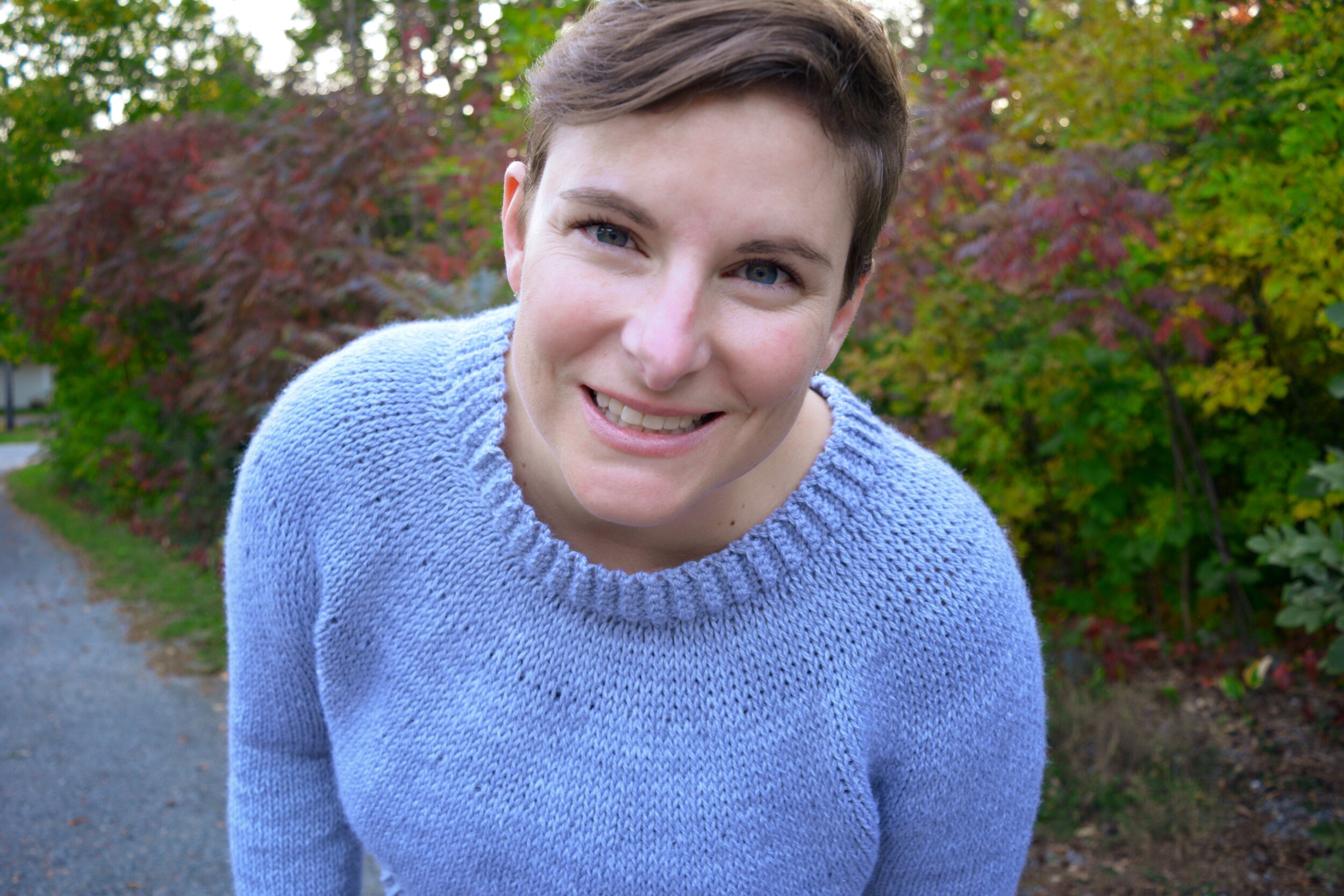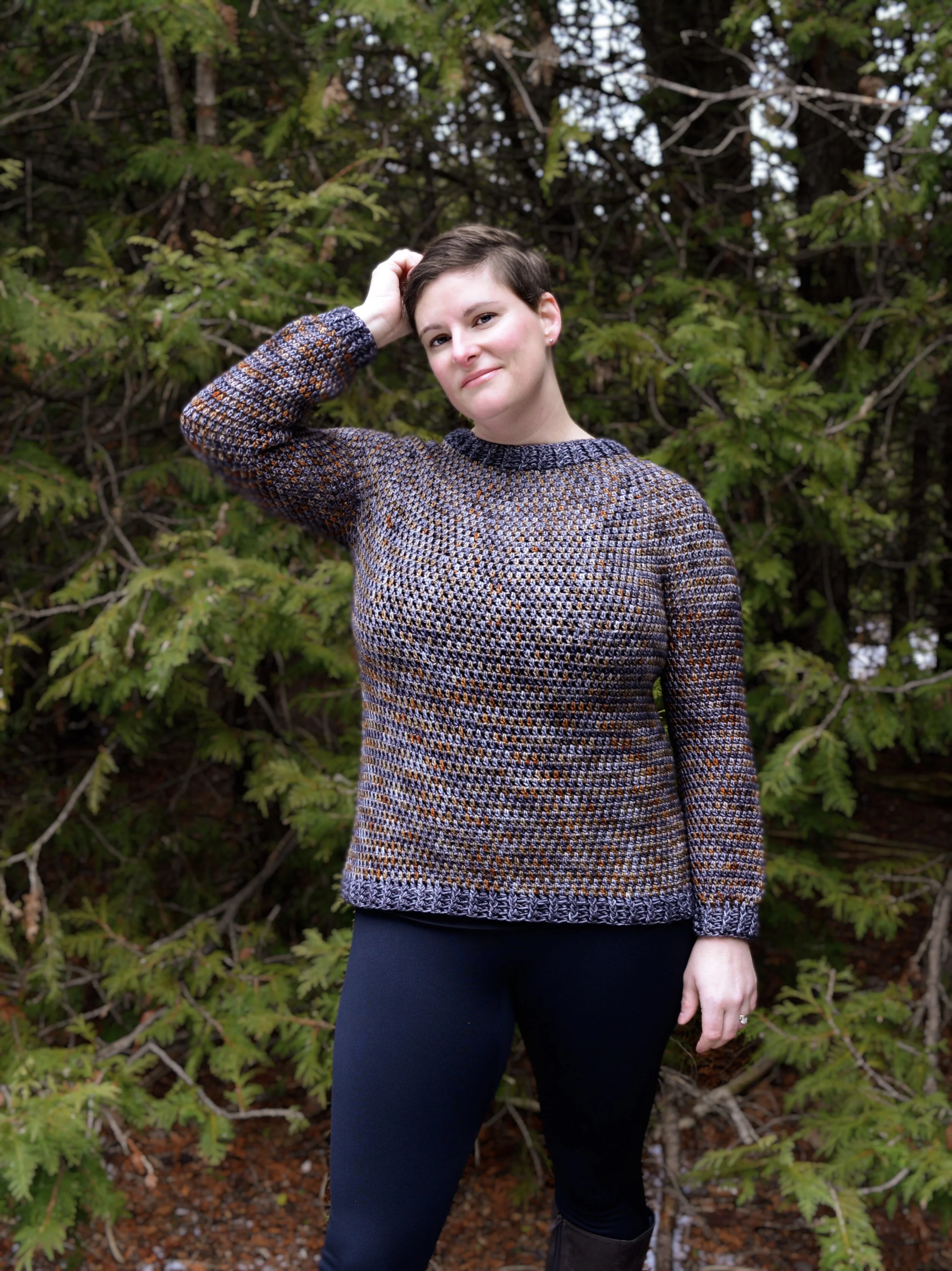Testing vs. Tech Editing
by Janine of @Capital.Crochet
Hello fellow fibre friend! I’m Janine from Capital Crochet, and today I’ll be talking to you about pattern testing and technical editing. Since you’re here on The Skeiniac’s Pattern Testing Blog, I assume you’re familiar with what pattern testing is – but what about tech editing?
If you are a designer, you are likely familiar with the pattern testing process. So how does tech editing differ? In this post I’ll highlight the basics of pattern testing and tech editing, discuss a few key differences, and answer some commonly asked questions.
Janine is pictured above wearing her free Winter Sparkle series patterns (check them out on her blog!).
Below, she is wearing her Coniferous Cowl pattern; the Classic Tunisian Pullover by @HookedHazel; the Prim Stripe Pullover by @LittleRedKnits; and the Puffy Kerchief Cowl by @JourneyChanelDesigns.
Testing
What exactly is required of a tester? The short answer is, whatever the designer wants you to do. Some designers have specific requirements in the form of feedback surveys, or specific information they want you to provide.
Generally speaking though, the basic requirements of testing a pattern are:
Make the assigned size or variation as written (unless the designer has approved modifications)
Identify any size-specific pattern errors, such as stitch counts
Identify any comprehension and/or clarity issues (this is why testers of all skill levels are useful in a test, no matter what the level of the pattern is!)
Provide finished measurements, yarn and yardage info and other relevant details such as hook size or gauge achieved
Provide pictures – this can include in-progress work as well as the finished item
Help with promotion of the pattern lead up to and on release day
Designers often list out their specific requirements in the post soliciting testers, and/or in the pattern testing application. Some designers will have very specific feedback that they require, such as a list of points to cover or a feedback form. They will also include requirements for photos and additional responsibilities such as when and how many social media posts, and creating a project on Ravelry.
As a tester, it is your responsibility to ensure you complete the test according to the designer’s requirements. Check out TheSkeiniac's Tester Tips Page for a more detailed look at the ins and outs of pattern testing!
Technical Editing
Have I lost you already? I know it sounds, well, really technical. So let’s break it down.
As with pattern testing, the duties of the tech editor can vary depending on the type of pattern, the designer preferences, and the stage of pattern development. The most common tasks a tech editor is responsible for are:
Editing all sizes to ensure correct pattern instructions (lots of math!)
Verifying gauge against pattern instructions and all final measurements (more math; spreadsheets are my friend!)
Confirming that all necessary and relevant sections and information are present and complete
Evaluating spelling, grammar and comprehension and making corrections and suggestions
Ensuring consistency throughout the pattern (fonts, language, abbreviations, etc.)
Making aesthetic suggestions on format and layout, if required
Some tech editors also offer grading, charting and diagram services as well. Different tech editors will be more proficient in certain areas or specialize in certain things. When I edit a pattern, I do all of these things and more, but my forté is in the small details, like finding extra spaces and missing or extra letters, ensuring consistent formatting and language, and making aesthetic suggestions. You would be surprised at how much of a difference these small things can make to the overall look of a pattern!
As you can see, some of the work a technical editor does is similar or the same as a pattern tester. For example, while a pattern tester must be on the lookout for stitch count or pattern errors in their size, the technical editor will do this for ALL sizes. The main difference is that a technical editor does not normally make the item. They simply work with the information provided to try and make sure that the instructions will create the item in the way the designer has intended. Also, pattern testers normally do the test for free with their own materials. A tech editor will charge for their services, and this can be in the form of flat-fee or package-based plans, or hourly rates.
Now that you’ve got a good grasp on the details of pattern testing and tech editing, I’d love to answer some common questions. Hopefully these give you a better understanding of the benefits of both processes.
My pattern is simple, do I really need to have it tested and/or tech edited?
The short answer is – it depends. Are you confident the pattern is error-free? Do you have enough pictures to adequately display all sizes/variations? I’ve seen others say that a pattern that is not tested or tech edited is automatically subpar – I do not subscribe to this opinion, because every pattern and every designer is different. My personal opinion is that if you have time to get a pattern tested before releasing it, it can’t hurt. Even if the pattern is perfect, having pictures of it worked up in different yarns or worn in different sizes can really help with pattern promotion! As for tech editing, if you are confident that your pattern is the best it can be, then that’s what matters. When a designer sends me a near perfect pattern, I will always have suggestions. Not because I’m nit-picking, but because I try to consider the pattern from the perspective of many possible makers. But in the end, the pattern is ready for release when the designer says so.
My pattern is going to be free, so why would I spend money having it tech edited?
This is a common one, but consider this – just because you are releasing a free pattern, it doesn’t mean you should be ok with lower quality. If you’re putting it up for free on your blog, it should still make sense, be error-free (pattern as well as spelling, grammar, etc.), and it should still look good. I assume that most people who release free patterns are doing so with some goal in mind, whether that’s increasing traffic to your blog, getting your name out there or contributing to a CAL or other group project. Your name is still attached to that, and you want people to say “Wow, this is FREE?” instead of “no wonder this is free…”
How do I choose a tech editor?
As I mentioned above, different tech editors will be stronger in some areas or work well with certain people. For example, I am not strong in knitting, so I accept mostly crochet and Tunisian crochet patterns (I have done a few simple knitting patterns, but I’m always up front about my limited knowledge!). Personal preferences and style come into play as well – some people work really well together, and others will not have that warm, fuzzy feeling. If you’re looking for a tech editor, I recommend asking around to other designers to see who they use or would recommend. You can also reach out to tech editors that you know, and get a feel for their work. Ask them who they’ve worked with and what patterns they’ve edited. Then you can have a look for yourself and judge whether they’d be a good fit for your patterns.
Should I have my pattern tech edited or tested first – does it matter?
Most of the designers I work with will write the pattern, then send it to me for editing prior to sending it out to their testers. Doing it this way gives the designer a chance to make adjustments or correct any show stoppers that the tech editor will catch, so they’re not scrambling to fix things during a testing period. However, if there was an issue brought up during testing, the pattern can always be edited afterwards. If you’re not having a pattern tested, then I highly recommend allowing some time prior to publishing for a tech editor to go over it and ensure it is the best it can be. You can even send published patterns for editing, if you’re getting feedback from makers and feel there may be an issue. Ultimately it is up to you as the designer to organize your process for what works best for you.
My tech editor missed some details that my pattern testers caught (or vice versa). Does this mean they aren’t doing a good job?
First of all, tech editors and pattern testers are human – mistakes are part of life! This situation is why I would recommend having your more complex patterns tested AND tech edited. Sometimes, a detail or technique in a pattern doesn’t lend itself well to visualization, so a tech editor may misunderstand or misjudge something that gets sorted out in the testing phase. Pattern testers generally only test one size, so if you don’t get testers for a certain size, something may be missed in those instructions that a tech editor could pick up on. If you think your tech editor or tester missed something important, offer feedback! I think there is always room to learn new things, no matter your level of experience or expertise. Also, if you don’t like the way a tester or tech editor works, you are not normally obligated to hire them or work with them again. Find someone who vibes with you, and you’ll find that you grow together!
I’m a pattern tester who really loves providing feedback – should I become a tech editor?
This is how I got my start, but it’s not for everyone. If you are interested in making the leap from tester to tech editor, I suggest talking to other tech editors about their experience. There are courses you can take as well, but it’s important to remember that everyone’s path is their own – there’s no right or wrong way to get to where you want to go. And if you’re a tester who just loves testing, that’s ok too!
♡♡♡
I hope you’ve enjoyed this little look into testing vs. tech editing. For more information about me and my process, you can visit My Tech-Editing Website . If you have questions, comments or suggestions, don’t hesitate to reach out via email, or send me a DM on Instagram.
Thanks for reading!




